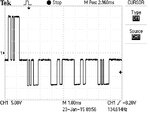cool.man
Full Member level 6
Hi everyone
I want to know how i read this data which is transmitted from RS232 (PC side) of the following side.

Settings are:
Baud Rate = 9600
No of data bits = 8
Parity = None
Stop bit = 1
Normally there are two states, logic 0 (3v to 25v) and logic1 (-3v to -25v).
But in the above diagram there is another state which is appox at -3v. So how should i read the data bits?
I want to know how i read this data which is transmitted from RS232 (PC side) of the following side.

Settings are:
Baud Rate = 9600
No of data bits = 8
Parity = None
Stop bit = 1
Normally there are two states, logic 0 (3v to 25v) and logic1 (-3v to -25v).
But in the above diagram there is another state which is appox at -3v. So how should i read the data bits?